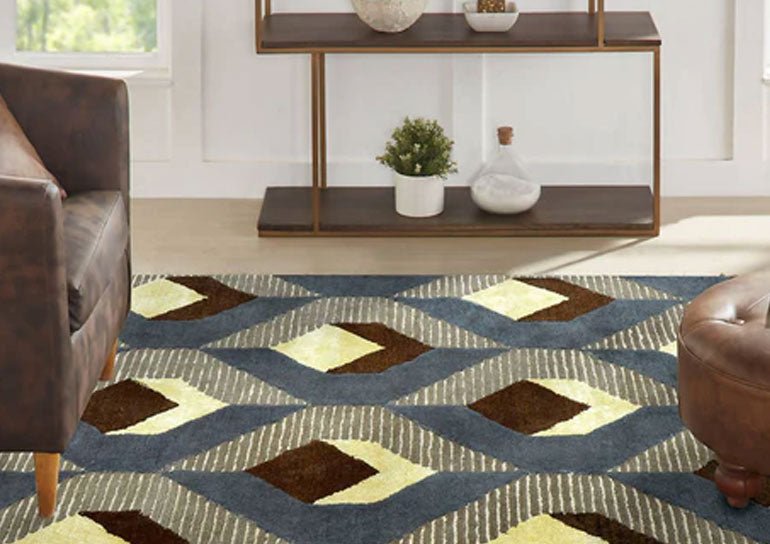What Makes Rugs Work Of Art?
Posted by VILLEDOMO INDIA

If there is one element of house décor that has endured through the ages, it would have to be the carpet or rug. (the two words are now often used interchangeably.) The carpet first gained popularity as a decorative and valuable object in the 16th century during the Safavid dynasty, notably during the rule of Shah Abbas. It had previously been used as a practical item (to warm the hearth, as prayer mats, or as a form of exchange). They are still referred to as "Shah Abbas" rugs in Iran in honor of the monarch. Some handcrafted rugs can be extremely expensive today. When Marco Polo travelled back to the Occident with tales of brilliant rugs found in the Orient, woven in silk and encrusted with gems, Europe discovered the famous Persian rugs. They probably did back in the day as well because they were exchanged as gifts and symbols of a pledge of allegiance between kings.
This most popular home décor item can still elicit feelings, tell a narrative, and illuminate a space—everything that a beautiful work of art can. But why are handmade carpets such prized possessions?
Handmade Rugs Are Exclusive
No two handmade rugs will be the same, regardless of pattern, color, weave, or any other factor. Handmade products inevitably have unavoidable pattern irregularities that give the carpet a special charm. They are expressions of the artist's artistic identity as opposed to objects produced by machines that produce identical items while masking signs of unique craftsmanship. A particular Oriental or Persian rug typically only appears once and is not produced in multiple sizes. A handmade rug's appeal and personality are found right here. You will be the proud owner of a singular work of art because each piece is original.
Did You Know?
Rug-making was brought to India by Babar in the sixteenth century, but it thrived under Akbar, who was an acclaimed patron of the arts.
Handcrafted Rugs Are The Pinnacle Of Exquisite Design
Through their handmade works, artists frequently convey their distinctive fusion of nations, storytelling prowess, and inspiration. The same holds for hand-woven carpets, where the creator's talent and comprehension of the pattern are exclusive to them. What distinguishes a carpet as a work of art is the meticulous attention to detail used to bring patterns to life over extended periods. What unending pleasure it is to handle a carpet that is exquisitely woven and to ponder who or what inspired its creation.
Did You Know?
In 1949, a Scythian nobleman's grave was discovered at Pazhyryk, Kazakhstan, containing the earliest known carpet, known as the Pazhyryk rug, which dates to roughly the 4th century BC. It was made of sheep's wool and strangely kept its shape despite being frozen in the ice.
The Distinguishing Element Is Skilled Execution
Most hand-made rugs are either flat-woven, loomed, tufted, or knotted. (kilims). Hand-knotted rugs are the best of the best when it comes to carpets. The quality of the flooring can be determined by the knot density. One can gauge the caliber of these rugs by counting the knots in each square inch on the reverse of the rug. The quality, longevity, and distinctiveness of the rug's pattern improve with increasing knot density.
In general, good quality carpets are rugs with over 330 knots per square inch. Carpets of the highest calibre have over 1,000 KPS. Therefore, it is completely normal that a carpet can take months or even years to make, and that is what gives it its value.
Their Worth Rises Over Time
A well-made rug can last for many years without displaying significant signs of wear and tear; this trait enables it to be handed down through the generations as an heirloom, raising its value. Natural fiber carpets with a healthy knot density that are dyed with vegetable inks and made of natural fibers like wool, cotton, or silk have the base needed for long-term sustainability. When the prints on naturally dyed rugs start to wane after years of use, they can be over-dyed to restore the colors, or they can be left the way they are to give them a more unique vintage look.
Did You Know?
Rugs made before the 1930s are regarded as antique, whereas those produced after the 1950s are regarded as vintage.
Rugs Are Adaptable
Rugs don't typically decorate the walls of every dwelling. However, when you do, it is noticeable. Although tapestries are a distinct textile art form, carpets and rugs can also be used to decorate walls. They indicate the house's unique personality. They act as sound absorbers, add texture, color, and warmth when placed on the ground or mounted on walls, and they also make a strong design statement.
The idea of using rugs as artwork is exciting and has limitless potential. They impart the same life and display comparable artistic sensibilities as a lovely picture or a finely carved sculpture. It wouldn't be an exaggeration to state that most rooms, whether on the floor or the wall, would benefit from a rug.

